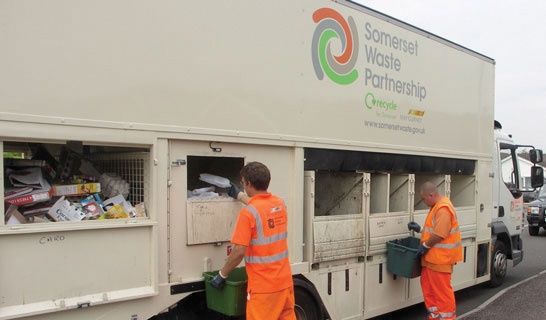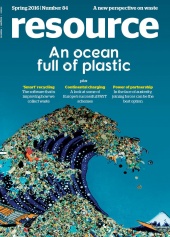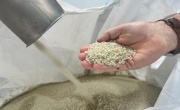A match made in waste
Love and marriage might go together like a horse and carriage, but what about waste and partnerships in local government? Leonie Butler reports on the growing number of authorities going it together.
Ask anyone in a relationship and they will tell you that partnership takes work. You have to remain independent, while agreeing to work together to achieve common goals, sharing a vision of the future. You have to keep each other informed of your plans and take the highs and the lows of the journey, supporting each other in times of crisis, through bad patches and rejoicing when things go well. And woe betide those who think a partnership won’t change them at all – you have to change the way you organise yourself to take into consideration your other half. You have to invest time and emotion (and understand those emotions – but more of that later).
Since Resource last visited the topic of waste partnerships in 2011 (see Resource 59, ‘Partners in Grime’), collaboration amongst local authorities has grown, be that through informal groups, sharing best practice, or formal arrangements with shared services and integrated contracts.
Whatever form they come in, though, the biggest motivating factor for entering a waste partnership is probably the potential to make savings through economies of scale by coordinating services across larger geographic areas. Rob Gillies, Managing Consultant at Eunomia Research and Consulting, notes: “Budget pressures continue to encourage local authorities to explore ever-closer ways of working together and waste and recycling services are no exception. Where local authorities can find ways to join up services such that administrative boundaries cease to be a constraint, a clear business case can usually be made for investing in partnership working to deliver savings through, for example: rationalising infrastructure such as depots and transfer stations, optimising collection rounds, reduced vehicle and labour cover costs, reduced procurement costs and savings from combining management and admin teams.”
Indeed, the knife-wielding central government explicitly promotes waste partnerships as a means of making savings. In a Department for Communities and Local Government report in March 2015, ‘Household Waste Collection: Procurement Savings Opportunities’, Local Government Minister Kris Hopkins said: “We know some county-level Resource and Waste Partnerships have facilitated joint procurement for their districts and this is welcomed. But neither a district nor county boundary prevents the buying of goods with local authorities further afield where opportunities to generate savings are concerned.”

The Local Authority Recycling Advisory Committee (LARAC), meanwhile, estimates that the majority of English two-tier areas have a waste partnership in place, around 50 in total, though only a few have ‘advanced waste partnerships’, fully joined-up services and teams.
The most well known and talked about partnership, perhaps, is that found in England’s south-west. Somerset was the first county-wide area to combine waste service funding under a single committee of councillors from each of the six local councils. As a formal partnership, the authorities have delegated their powers in relation to waste services to the Somerset Waste Board, which delivers this obligation through its executive arm, the Somerset Waste Partnership (SWP).
A single contract for recycling and residual waste collection across the whole county started successfully in October 2007. The single contract replaced nine other contracts, all with slightly different specifications, resulting in savings of £1.7 million a year. It has also, according to the councils, increased customer satisfaction and recycling rates.
Managing Director of Somerset Waste Partnership Steve Read, also Head of Service at the Gloucestershire Joint Waste Partnership, says Somerset was in the right place at the right time to make the change: “Political consensus and the ability to manage contract end dates without waiting a long period played huge roles in the formation of the SWP and the letting of a single collection contract across a whole two-tier county.”

Read continues that it’s not always as straightforward: “Gloucestershire’s governance model draws heavily from the SWP template, but the story has been perhaps more typical – getting all potential partners to the same place at the same time is very difficult. But that did not deter those [who] were up for forming a coalition of the willing and keeping the door open to those who have yet to commit. The two non-participants in the Gloucestershire Joint Waste Committee are invited to send co-opted members to each public meeting of the committee. They can’t actually vote along with the full members but they contribute to the debate and, with a consensus building approach, a show of hands is not often needed.”
Read’s mantra is that ‘shared teams provide resilience’: “I see many councils losing and not replacing staff and making themselves vulnerable to ineffectual contact management and poor procurement. Concentrating expertise in one team is helpful.”
Noting that partnerships, however, are not without their difficulties, he goes on to explain that there may be some ‘baggage’ (a common theme in new relationships!). He says: “People appointed as partnership officers under any model need to be consensus builders and not aligned with any one particular partner... It can be high maintenance initially but, once trust builds, then the simplicity of one basic system, one set of messages, and one main decision-making body to look at the whole picture is compelling.”
Most waste partnerships, though, have developed on a more informal basis, with fewer powers delegated to the partnership body. The partnership might develop a joint waste strategy and amalgamate communications, but service delivery and budgets are retained by the individual councils. The Local Government Association reports that at least 95 per cent of all English councils have now engaged in some form of shared service delivery, with most of the focus on back office functions. Indeed, Read refers to such arrangements outside the formal partnerships: “There are examples in both Somerset and Gloucestershire where waste partners share management resources with districts in neighbouring counties. The map is messy and complicated but the synergies of shared waste support services are just as valid as sharing legal, finance and many other services.
“Similarly, while professional expertise is actually fairly easily deployable across municipal boundaries – RCVs and recycling trucks can be too with a little pre-planning and a putting aside of the myth that each council has very different needs.”
Paul Vanston, head of the combined waste service of South Cambridgeshire District Council and Cambridge City Council (and previously Manager of the Kent Resource Partnership) adds: “It’s the vision, direction and commitment of councils working together that tends to garner the best results – and the form of governance chosen could either help or hinder that.”

To help along the way, social enterprise Improvement and Efficiency Social Enterprise (iESE) published a Waste Partnership Routemap in 2011, funded by Defra via the Waste & Resources Action Progamme (WRAP). Gillies, part of the Eunomia team that created the route map for Defra/iESE, explains: “The route map was developed based on our experience in supporting the establishment of a number of formal waste partnerships in England and is designed to guide local authority officers through a series of stages including: planning for partnership, getting a mandate (i.e. outline business case), setting up the project team, finalising the business case and implementing the partnership.” However, iESE are ‘in the process of considering removing the route map from their site due to its date’.
To anyone cautious of forming a partnership, Read suggests that an exercise mapping where each partner is at this moment in terms of contracts, the need to procure vehicles, appetite to review service model, and so on, will help give a picture of where in the future there is opportunity to join up. The current interest in consistency in collection methodology may be another driver in taking a longer-term view. He says: “I would strongly recommend that a clear and robust model is used to determine how any central support/single unit is paid for and ensure that what goes in – and what partners can expect out – is fairly apportioned. This needs really strong financial support. A huge factor in Somerset’s success has been the way that the administering authority has provided top notch finance officers under a service-level agreement who can take off their county council hats and wear the waste partnership cap when appropriate.”
When asked if partnerships are a good thing, Andrew Bird, Chair of LARAC, comments: “In my opinion, yes, and in the current climate of reducing public finance and poor market conditions for materials, their importance is more relevant than ever. There are some really good examples of partnerships – Somerset, Kent, Hampshire spring to mind – and now we have another type of partnership development, Resource London, which will support all of London’s waste authorities to help increase rates of recycling, maintain high standards of service, and reduce costs. The issues they face are complex, but only by working in a partnership approach will they solve them.”
Third sector partnerships
Of course, local authorities are also increasingly partnering with third-sector groups to drive up reuse.
WRAP advocates such partnerships, and last year launched a suite of materials to show how to do it. Linda Crichton, Head of Resource Management, explains: “The ‘How to guide on making reuse a strategic priority’ has info about establishing reuse as a strategic priority for local authorities and
their partners. It provides a step-by-step approach for building a case for a reuse strategy and the environmental, social and economic benefits this can bring.”
According to WRAP, the benefits of such partnerships are many: ‘In 2012, the third sector benefitted by an estimated £430 million through reuse, and reuse organisations created 11,000 full-time- equivalent jobs. WRAP estimates that UK households also benefitted by some £6 billion through reuse in 2012, including giving people access to more affordable products.’
Crichton comments: “The actual benefits for each local authority will be different, but we have provided advice on how they can quantify them through working out where they are now and monitoring and evaluating the progress they are making... There are various calculators and tools available that help with this process in this guide and at the Household Waste Prevention Hub.”
She continues: “It doesn’t really matter what you call it. It could be a steering group, an association, a network. It can be informal quarterly meeting or a formally constituted group (the guide covers this). Where we have seen reuse forums, we have really seen reuse take off. It gives an opportunity for LA staff, waste management company staff and third-sector groups to see where each other’s strengths lie and work to those. Our case studies show once the social, economic and environmental benefits and value are shown, the corporate social responsibility is clear and this often means barriers can be addressed and progress made.”
 This article was taken from Issue 84
This article was taken from Issue 84WRAP lists good coordination, communication – both internally and with the public – and actively keeping partners engaged and reporting to delivery of an action plan (not just being a talking shop) as key to maintaining the partnership.
Two such partnership projects have developed in Buckinghamshire. The first saw reuse built into a household waste recycling centre (HWRC) contract, enabling a charity to set up shops on two HWRC sites.
The charity shops sold over 45,000 items in their first year of operation, equating to nearly 500 tonnes of material being diverted from landfill and saving £40,000 in disposal costs.
The second led to the creation of Buckinghamshire Re-Use Forum, comprising of five local authorities, seven reuse organisations, three housing associations and three waste management contractors. The forum helps to generate stock for the shops and raise awareness of furniture reuse.
Another successful scheme has been set up in Leeds, where the city council has partnered with local furniture reuse organisations to maximise reuse from social housing and reduce bulky waste going to landfill. Leeds City Council (LCC) has also been working with WeeeLink to better manage electrical and electronic equipment (EEE). Having monitored EEE coming into HWRCs, LCC estimated 17,000 potentially reusable items are instead being recycled at just one of its HWRCs each year. In a trial to recover some of this EEE, the council was able to capture nearly 200 items at two sites over two months. Sixty of these items were sold for a total of £1,500. 




